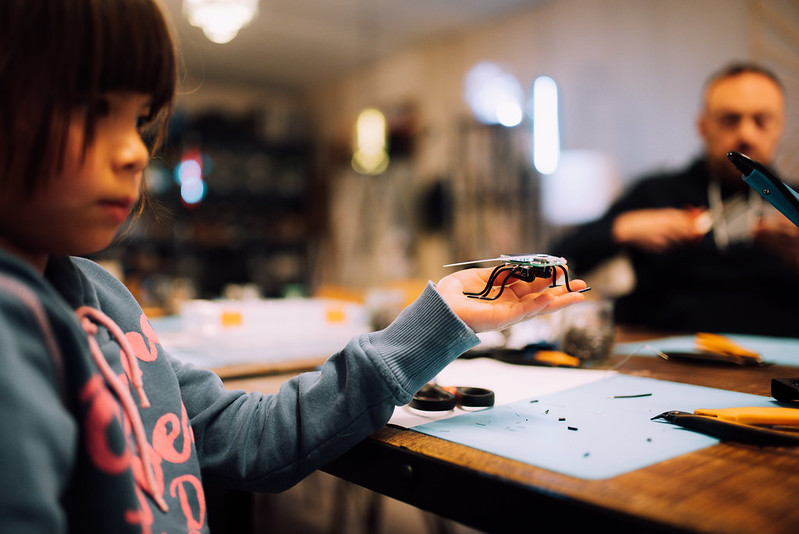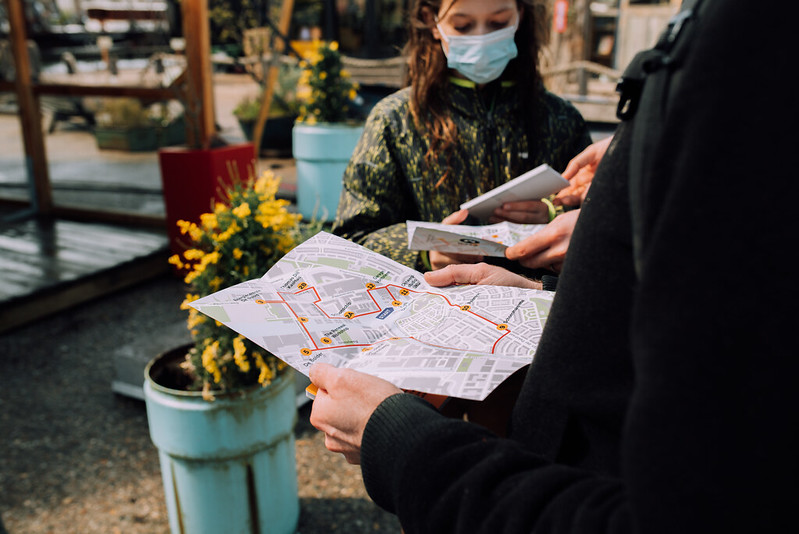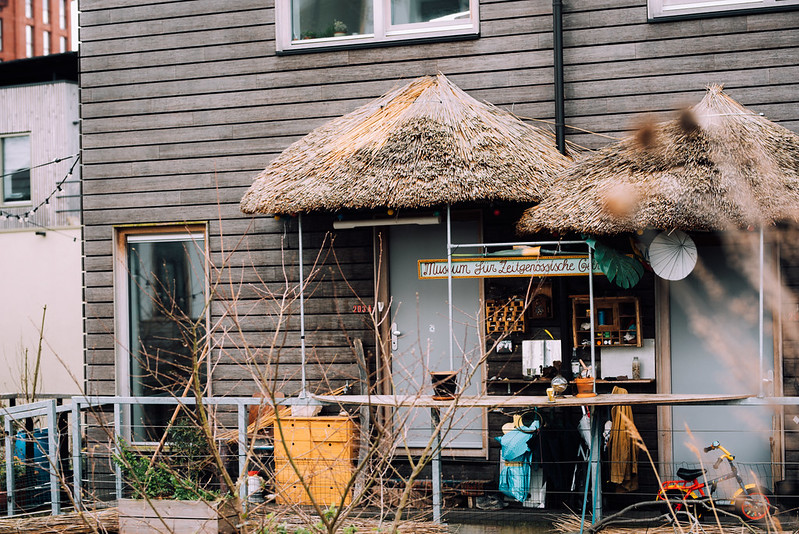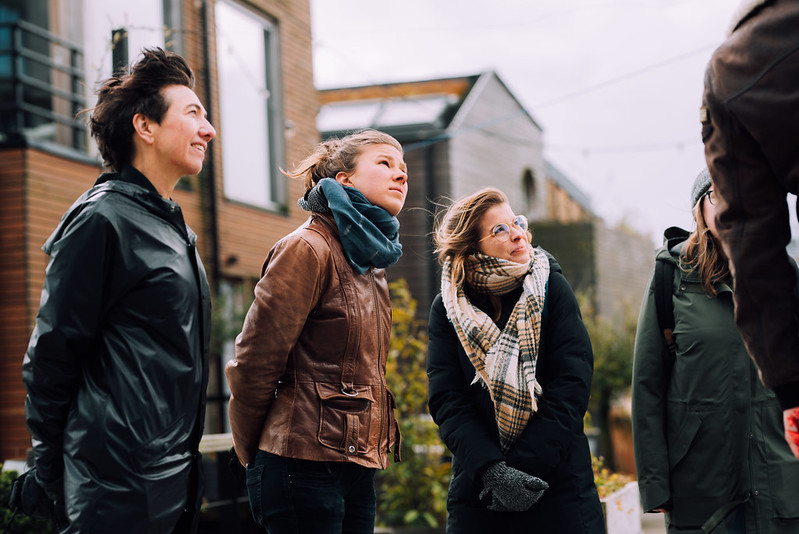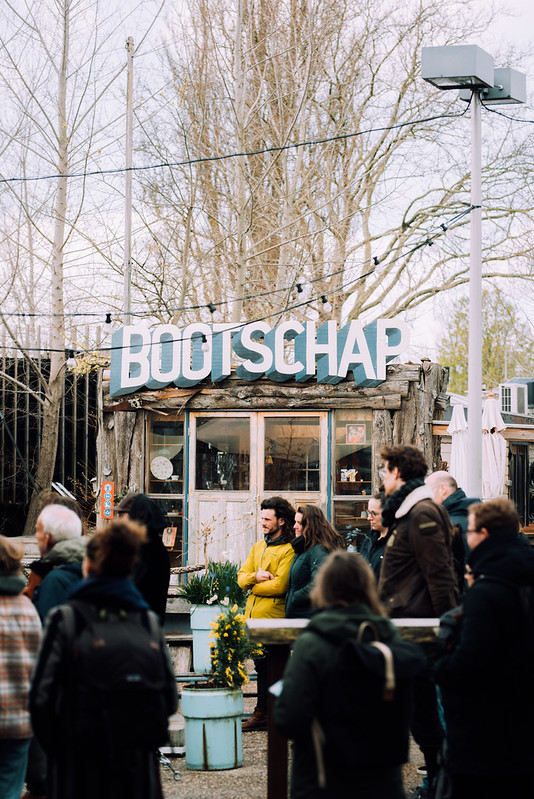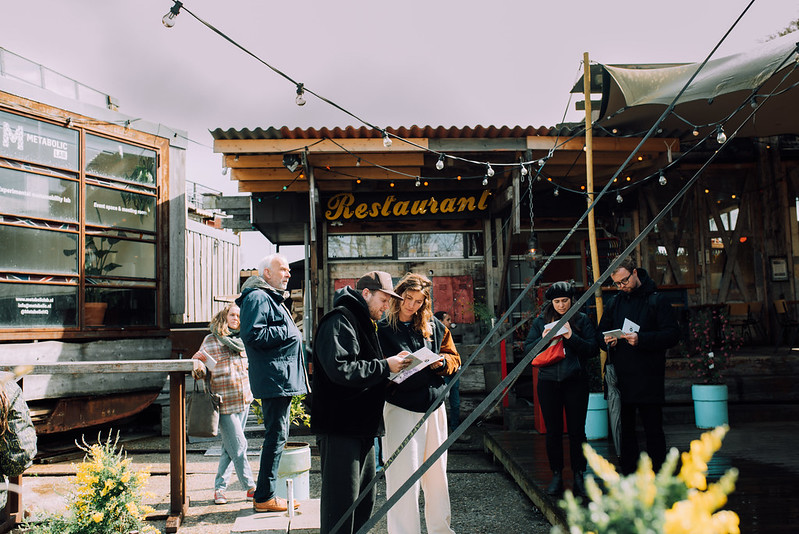By Ashley Laflin and Julia Jansen, WAAG
In March and April, in cooperation with the projects Atelier and Centrinno, Pakhuis de Zwijger and architect Thijs van Spaandonk, two afternoons of events were organized in Amsterdam Noord. Through a neighbourhood walk and a firefly workshop, participants were challenged to think about their role in a transition to a sustainable future.
Lighting the way: firefly building workshop for children
Waag partnered with designer, inventor, and artist Eibert Draisma to host a workshop that taught children to build solar-powered fireflies. The aim of the event was to increase energy awareness and empower the makers of the future through a low-threshold activity. At the start of the workshop, Draisma gave a tour of his workspace and projects, including a frog simulator and a robot dog.
After the tour, children were provided with instructions (as well as adult helpers) that walked them through the steps of assembling and soldering together the fireflies made from printed circuit boards and mini solar panels. The children, many of them quite serious about completing their project, were able to interact with each other while learning about electronics. Some of the young participants decided to put their own creative spin on the project, creating a new pattern for the wing shape of the firefly.
At the end of the workshop, each child was encouraged to name their firefly and bring them home to charge in the sun. Through bringing the firefly home and having to wait until the firefly was charged enough to emit light, children were able to learn about solar power.
Have a look at the photos by Jimena Gauna and the film impression down below.
A step forward: walking through the city of the future
In honour of the opening of the Ware Noorden Lichtroute, Waag hosted a walk featuring organisations working toward a sustainable city. Prior to the walk on March 12, Socrates Schouten from Waag and architect Thijs van Spaandonk shared inspiration for the route and pointers where to see hidden energy infrastructure all around us. The walk is a way to experience the future of the city – not an imagined future of flying cars, but a future that is built in the here and now through current initiatives in the neighbourhood.
As described in the citizen engagement plans, walking as an engagement method can involve all target groups, especially (future) residents and other citizens interested in the development of Buiksloterham and/or with a specific interest in the energy transition. These activities focus on what is visibly or invisibly changing in the area regarding the energy transition and how residents relate to that. It is both an open space to get informed about ways in which residents and current organisations are (sometimes implicitly) already involved with the energy transition, as well as a way to inform residents on implications of the transition to renewable energy.
Each stop was intended to introduce the walker to a location where the transition to renewable energy is visible, or where ‘we see the future happening.’ Amsterdam has set a goal of being heated without gas by 2040 and increasing renewable electricity production by 127 MW by wind energy and 400 MW by solar energy in 2030. Residents and communities play a big role in realizing the transition. As such, one of the aims of the walk was to show what residents and neighbourhood organisations do for the transition. The group of walkers was challenged to reflect on renewable energy and sustainability: what must be considered for a sustainable future?
Attendees were given a map of the route as well as cards that provided questions to ponder at each site like ‘many of us live in (rental) houses that we cannot (re)build and better isolate ourselves – what can we do?’ Walkers also stopped at a soil remediation site at a former garbage incinerator and were challenged to think about how our energy production choices have an impact on the built environment. ‘What do we find important for our energy production installations? How does it change when we would share in the profits?’ Stops ranged from the two apartments with an innovative design to maintain a comfortable temperature inside throughout the seasons, to social circularity hub in a social housing complex, where the focus lies on solidarity, reuse of water, energy and material. Along the way, walkers were encouraged to read the cards together and engage in conversation at the stops. Midway through the route, walkers took a break at thrift store and social enterprise De Lokatie to warm up with a cup of tea or coffee and to continue the conversation about the walk with one another. During this break, one walker noted that the route provided a good opportunity to see the city from a different perspective.
Next steps: inspiration for the future
Through both the walk and firefly workshop in Noord, participants were challenged to think about their role in the future, be it through a lesson on solar power in the firefly workshop or visiting stops on the walk that exemplify efforts undertaken for a more sustainable future. While it is not possible to turn the entire city into a circular system overnight, many reflected on finding inspiration through the events and felt challenged to consider efforts they could personally make.
For Waag, the walks provided a possibility to learn about community initiatives in the energy transition and considerations of the walkers related to renewable energy. The walk contributed to connections with local residents as well as entrepreneurs and innovators.
Two residents, walkers who live in cooperative housing in Noord, spoke about how the sites on the walk showed them that there were others in the area working toward sustainability outside their bubble. Similarly, another walker said she also felt inspired but acknowledged that there’s really still a lot of work to do. Despite the effort it will take to build a better future, the walk led her to think about how she can participate in projects that work toward sustainable and circular goals.
Credits for images: Jimena Gauna, Waag
This article was originally published on the website of Waag: Waag | Building a circular future: an afternoon in Noord
